Section I.
Of the motion of bodies that are resisted in the ratio of the velocity.
Proposition i. Theorem I.
If a body is resisted in the ratio of its velocity, the motion lost by resistance is as the space gone over in its motion.
For since the motion lost in each equal particle of time is as the velocity, that is, as the particle of space gone over, then, by composition, the motion lost in the whole time will be as the whole space gone over. Q.E.D.
Cor. Therefore if the body, destitute of all gravity, move by its innate force only in free spaces, and there be given both its whole motion at the beginning, and also the motion remaining after some part of the way is gone over, there will be given also the whole space which the body can describe in an infinite time. For that space will be to the space now described as the whole motion at the beginning is to the part lost of that motion.
Lemma I.
Quantities proportional to their differences are continually proportional.
Let A be to A − B as B to B − C and C to C − D, &c., and, by conversion, A will be to B as B to C and C to D, &c. Q.E.D.
Proposition ii. Theorem ii.
If a body is resisted in the ratio of its velocity, and moves, by its vis insita only, through a similar medium, and the times be taken equal, the velocities in the beginning of each of the times are in a geometrical progression, and the spaces described in each of the times are as the velocities.
Case 1. Let the time be divided into equal particles; and if at the very beginning of each particle we suppose the resistance to act with one single impulse which is as the velocity, the decrement of the velocity in each of the particles of time will be as the same velocity. Therefore the velocities are proportional to their differences, and therefore (by Lem. 1, Book II) continually proportional. Therefore if out of an equal number of particles there be compounded any equal portions of time, the velocities at the beginning of those times will be as terms in a continued progression, which are taken by intervals, omitting every where an equal number of intermediate terms. But the ratios of these terms are compounded of the equal ratios of the intermediate terms equally repeated, and therefore are equal. Therefore the velocities, being proportional to those terms, are in geometrical progression. Let those equal particles of time be diminished, and their number increased in infinitum, so that the impulse of resistance may become continual; and the velocities at the beginnings of equal times, always continually proportional, will be also in this case continually proportional. Q.E.D.
Case 2. And, by division, the differences of the velocities, that is, the parts of the velocities lost in each of the times, are as the wholes; but the spaces described in each of the times are as the lost parts of the velocities (by Prop. 1, Book I), and therefore are also as the wholes. Q.E.D.
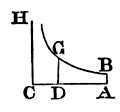
Corol. Hence if to the rectangular asymptotes AC, CH, the hyperbola BG is described, and AB, DG be drawn perpendicular to the asymptote AC, and both the velocity of the body, and the resistance of the medium, at the very beginning of the motion, be expressed by any given line AC, and, after some time is elapsed, by the indefinite line DC; the time may be expressed by the area ABGD, and the space described in that time by the line AD. For if that area, by the motion of the point D, be uniformly increased in the same manner as the time, the right line DC will decrease in a geometrical ratio in the same manner as the velocity; and the parts of the right line AC, described in equal times, will decrease in the same ratio.
Proposition iii. Problem I.
To define the motion of a body which, in a similar medium, ascends or descends in a right line, and is resisted in the ratio of its velocity, and acted upon by an uniform force of gravity.
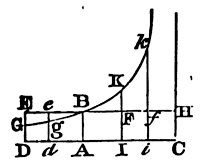
The body ascending, let the gravity be expounded by any given rectangle BACH; and the resistance of the medium, at the beginning of the ascent, by the rectangle BADE, taken on the contrary side of the right line AB. Through the point B, with the rectangular asymptotes AC, CH, describe an hyperbola, cutting the perpendiculars DE, de, in G, g; and the body ascending will in the time DGgd describe the space EGge; in the time DGBA, the space of the whole ascent EGB; in the time ABKI, the space of descent BFK; and in the time IKki the space of descent KFfk; and the velocities of the bodies (proportional to the resistance of the medium) in these periods of time will be ABED, ABed, O, ABFI, ABfi respectively; and the greatest velocity which the body can acquire by descending will be BACH.
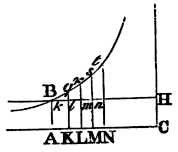
For let the rectangle BACH be resolved into in numerable rectangles Ak, Kl, Lm, Mn, &c., which shall be as the increments of the velocities produced in so many equal times; then will O, Ak, Al, Am, An, &c., be as the whole velocities; and therefore (by supposition) as the resistances of the medium in the beginning of each of the equal times. Make AC to AK, or ABHC to ABkK, as the force of gravity to the resistance in the beginning of the second time; then from the force of gravity subduct the resistances, and ABHC, KkHC, LlHC, MmHC, &c., will be as the absolute forces with which the body is acted upon in the beginning of each of the times, and therefore (by Law I) as the increments of the velocities, that is, as the rectangles Ak, Kl, Lm, Mn, &c., and therefore (by Lem. 1, Book II) in a geometrical progression. Therefore, if the right lines Kk, Ll, Mm, Nn, &c., are produced so as to meet the hyperbola in q, r, s, t, &c. the areas ABqK, KqrL, LrsM, MstN, &c., will be equal, and therefore analogous to the equal times and equal gravitating forces. But the area ABqK (by Corol. 3, Lem. VII and VIII, Book I) is to the area Bkq as Kq to ½kq, or AC to ½AK, that is, as the force of gravity to the resistance in the middle of the first time. And by the like reasoning, the areas qKLr, rLMs, sMNt, &c., are to the areas qklr, rlms, smnt, &c., as the gravitating forces to the resistances in the middle of the second, third, fourth time, and so on. Therefore since the equal areas BAKq, qKLr, rLMs, sMNt, &c., are analogous to the gravitating forces, the areas Bkq, qklr, rlms, smnt, &c., will be analogous to the resistances in the middle of each of the times, that is (by supposition), to the velocities, and so to the spaces described. Take the sums of the analogous quantities, and the areas Bkq, Blr, Bms, But, &c., will be analogous to the whole spaces described; and also the areas ABqK, ABrL, ABsM, ABtN, &c., to the times. Therefore the body, in descending, will in any time ABrL describe the space Blr, and in the time LrtN the space rlnt. Q.E.D. And the like demonstration holds in ascending motion.
Corol. 1. Therefore the greatest velocity that the body can acquire by falling is to the velocity acquired in any given time as the given force of gravity which perpetually acts upon it to the resisting force which opposes it at the end of that time.
Corol. 2. But the time being augmented in an arithmetical progression, the sum of that greatest velocity and the velocity in the ascent, and also their difference in the descent, decreases in a geometrical progression.
Corol. 3. Also the differences of the spaces, which are described in equal differences of the times, decrease in the same geometrical progression.
Corol. 4. The space described by the body is the difference of two spaces, whereof one is as the time taken from the beginning of the descent, and the other as the velocity; which [spaces] also at the beginning of the descent are equal among themselves.
Proposition iv. Problem ii.
Supposing the force of gravity in any similar medium to be uniform, and to tend perpendicularly to the plane of the horizon; to define the motion of a projectile therein, which suffers resistance proportional to its velocity.
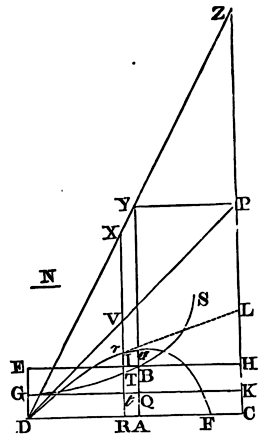
Let the projectile go from any place D in the direction of any right
line DP, and let its velocity at the beginning of the motion be
expounded by the length DP. From the point P let fall the
perpendicular PC on the horizontal line DC, and cut DC in A, so that
DA may be to AC as the resistance of the medium arising from the
motion upwards at the beginning to the force of gravity; or (which
comes to the same) so that the rectangle under DA and DP may be to
that under AC and CP as the whole resistance at the beginning of the
motion to the force of gravity. With the asymptotes DC, CP describe
any hyperbola GTBS cutting the perpendiculars DG, AB in G and B;
complete the parallelogram DGKC, and let its side GK cut AB in Q. Take
a line N in the same ratio to QB as DC is in to CP; and from any point
R of the right line DC erect RT perpendicular to it, meeting the
hyperbola in T, and the right lines EH, GK, DP in I, t, and
V; in that perpendicular take Vr equal to
tGT
N, or which is the same thing, take Rr
equal to GTIE
N; and the projectile in the time DRTG
will arrive at the point r describing the curve line DraF,
the locus of the point r; thence it will come to its
greatest height a in the perpendicular AB; and afterwards ever
approach to the asymptote PC. And its velocity in any point r
will be as the tangent rL to the curve. Q.E.I.
For N is to QB as DC to CP or DR to RV, and therefore RV is equal to
DR x QB
N, and Rr (that is, RV − Vr,
or DR x QB − tGT
N ) is equal to
DR x AB − RDGT
N. Now let the time be expounded by the
area RDGT and (by Laws, Cor. 2), distinguish the motion of the body
into two others, one of ascent, the other lateral. And since the
resistance is as the motion, let that also be distinguished into two
parts proportional and contrary to the parts of the motion: and
therefore the length described by the lateral motion will be (by Prop.
II, Book II) as the line DR, and the height (by Prop. III, Book II) as
the area DR x AB − RDGT, that is, as the line Rr. But in the
very beginning of the motion the area RDGT is equal to the rectangle
DR x AQ, and therefore that line Rr (or
DR x AB − DR x AQ
N ) will then be to DR as AB − AQ or QB
to N, that is, as CP to DC; and therefore as the motion upwards to the
motion lengthwise at the beginning. Since, therefore, Rr is
always as the height, and DR always as the length, and Rr is
to DR at the beginning as the height to the length, it follows, that Rr
is always to DR as the height to the length; and therefore that the
body will move in the line DraF, which is the locus of the
point r. Q.E.D.
Cor. 1. Therefore Rr is equal to
DR x AB
N − RDGT
N , and therefore if RT be
produced to X so that RX may be equal to DR
x AB
N, that is, if the parallelogram ACPY
be completed, and DY cutting CP in Z be drawn, and RT be produced till
it meets DY in X; Xr will be equal to
RDGT
N, and therefore proportional to the
time.
Cor. 2. Whence if innumerable lines CR, or, which is the same, innumerable lines ZX, be taken in a geometrical progression, there will be as many lines Xr in an arithmetical progression. And hence the curve DraF is easily delineated by the table of logarithms.
Cor. 3. If a parabola be constructed to the
vertex D, and the diameter DG produced downwards, and its latus rectum
is to 2 DP as the whole resistance at the beginning of the notion to
the gravitating force, the velocity with which the body ought to go
from the place D, in the direction of the right line DP, so as in an
uniform resisting medium to describe the curve DraF, will be
the same as that with which it ought to go from the same place D in
the direction of the same right line DP, so as to describe
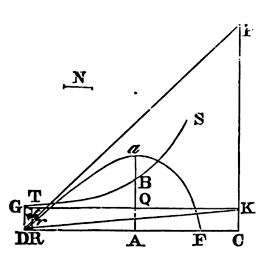 a parabola in a non-resisting medium. For the latus rectum of this
parabola, at the very beginning of the motion, is
DV2
a parabola in a non-resisting medium. For the latus rectum of this
parabola, at the very beginning of the motion, is
DV2
Vr; and Vr is
tGT
N
DR x Tt
2N. But a right line, which, if drawn,
would touch the hyperbola GTS in G, is parallel to DK, and therefore Tt
is CK x DR
DC, and N is
QB x DC
CP. And therefore Vr is equal
to DR2 x CK x CP
2DC2 x QB, that is, (because
DR and DC, DV and DP are proportionals), to
DV2 x CK x CP
2DP2 x QB; and the latus
rectum DV2
Vr comes out
2DP2 x QB
CK x CP, that is (because QB and CK,
DA, and AC are proportional),
2DP2 x DA
AC x CP, and therefore ist to 2DP as DP
x DA to CP x AC; that is, as the resistance to the gravity.
Q.E.D.

Cor. 4. Hence if a body be projected from any place D with a given velocity, in the direction of a right line DP given by position, and the resistance of the medium, at the beginning of the motion, be given, the curve DraF, which that body will describe, may be found. For the velocity being given, the latus rectum of the parabola is given, as is well known. And taking 2DP to that latus rectum, as the force of gravity to the resisting force, DP is also given. Then cutting DC in A, so that CP x AC may be to DP x DA in the same ratio of the gravity to the resistance, the point A will be given. And hence the curve DraF is also given.
Cor. 5. And, on the contrary, if the curve DraF be given, there will be given both the velocity of the body and the resistance of the medium in each of the places r. For the ratio of CP x AC to DP x DA being given, there is given both the resistance of the medium at the beginning of the motion, and the latus rectum of the parabola; and thence the velocity at the beginning of the motion is given also. Then from the length of the tangent L there is given both the velocity proportional to it, and the resistance proportional to the velocity in any place r.
Cor. 6. But since the length 2DP is to the latus rectum of the parabola as the gravity to the resistance in D; and, from the velocity augmented, the resistance is augmented in the same ratio, but the latus rectum of the parabola is augmented in the duplicate of that ratio, it is plain that the length 2DP is augmented in that simple ratio only; and is therefore always proportional to the velocity; nor will it be augmented or diminished by the change of the angle CDP, unless the velocity be also changed.
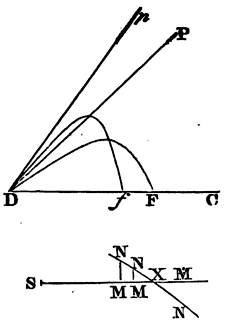
Cor. 7. Hence appears the method of
determining the curve DraF nearly from the phenomena, and
thence collecting the resistance and velocity with which the body is
projected. Let two similar and equal bodies be projected with the same
velocity, from the place D, in different angles CDP, CDp; and
let the places F, f, where they fall upon the horizontal
plane DC, be known. Then taking any length for DP or Dp
suppose the resistance in D to be to the gravity in any ratio
whatsoever, and let that ratio be expounded by any length SM. Then, by
computation, from that assumed length DP, find the lengths DP, Df;
and from the ratio Ff
DF, found by calculation, subduct the
same ratio as found by experiment; and let the difference be expounded
by the perpendicular MN. Repeat the same a second and a third time, by
assuming always a new ratio SM of the resistance to the gravity, and
collecting a new difference MN. Draw the affirmative differences on
one side of the right line SM, and the negative on the other side; and
through the points N, N, N, draw a regular curve NNN. cutting the
right line SMMM in X, and SX will be the true ratio of the resistance
to the gravity, which was to be found. From this ratio the length DF
is to be collected by calculation; and a length, which is to the
assumed length DP as the length DF known by experiment to the length
DF just now found, will be the true length DP. This being known, you
will have both the curve line DraF which the body describes,
and also the velocity and resistance of the body in each place.
Scholium.
But, yet, that the resistance of bodies is in the ratio of the velocity, is more a mathematical hypothesis than a physical one. In mediums void of all tenacity, the resistances made to bodies are in the duplicate ratio of the velocities. For by the action of a swifter body, a greater motion in proportion to a greater velocity is communicated to the same quantity of the medium in a less time; and in an equal time, by reason of a greater quantity of the disturbed medium, a motion is communicated in the duplicate ratio greater; and the resistance (by Law II and III) is as the motion communicated. Let us, therefore, see what motions arise from this law of resistance.